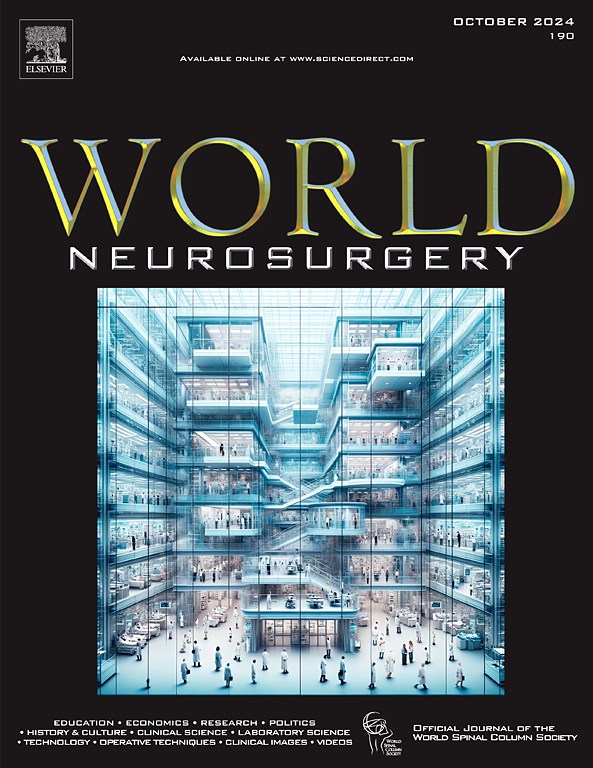Active Exchange of CSF for Rapid Removal of Blood in Hemorrhagic Stroke: Multicenter Experience in 40 Patients
IF 2.1
4区 医学
Q3 CLINICAL NEUROLOGY
引用次数: 0
Abstract
Background
Spontaneous intracerebral hemorrhage (ICH) and subarachnoid hemorrhage (SAH) may present with intraventricular hemorrhage (IVH). Prior studies show IVH correlates with increased mortality and morbidity. Neuroinflammation from blood organization in cerebrospinal fluid (CSF) contributes to poor outcomes.
Objective
We hypothesized that active external ventricular drainage (EVD) would accelerate blood removal, reducing adverse events. Study sites used double-lumen EVDs with active irrigation and intracranial pressure control via passive drainage.
Material and Methods
Data from 6 centers in the EU and USA were analyzed. Forty patients in total were included: 21 with SAH, 13 with spontaneous ICH-related IVH, and 6 with vascular anomaly-related hemorrhage. Blood removal was assessed via CT imaging. Shunt dependency in SAH patients was calculated using CHESS scores.
Results
Blood removal via active EVD was safely achieved. Removal pace correlated with irrigation volume. All 13 ICH patients had median IVH clearance of 91.3% (range: 0.7%–100%) over 7.6 days. SAH patients showed lower shunt dependency (2) than expected (11) per CHESS scores and literature. The vascular anomaly group had median IVH clearance of 91.3% over 8 days. No CSF exchange-related infections occurred.
Conclusions
Accelerated blood removal from the CSF system via active EVD is safe and feasible. Active irrigation reduced adverse events. Blood clearance is strongly linked to irrigation rate. Prospective trials are needed to identify the patient population most likely to benefit from CSF exchange during hemorrhagic stroke treatment.
出血性脑卒中患者主动脑脊液交换快速脱血:40例患者的多中心经验
背景:自发性脑出血(ICH)和蛛网膜下腔出血(SAH)可能伴有脑室内出血(IVH)。先前的研究表明,IVH与死亡率和发病率增加有关。脑脊液(CSF)中血液组织的神经炎症导致预后不良。目的:我们假设主动心室外引流(EVD)可以加速血液清除,减少不良事件。研究地点采用双腔evd,主动冲洗,通过被动引流控制颅内压。材料和方法:对来自欧盟和美国六个中心的数据进行分析。40例患者:SAH 21例,自发性ich相关IVH 13例,血管异常相关出血6例。通过CT成像评估血液清除情况。SAH患者的分流依赖使用CHESS评分计算。结果:通过活性EVD进行血液清除是安全的。清除速度与灌水量相关。所有13例脑出血患者在7.6天内IVH清除率中位数为91.3%(范围:0.7-100%)。SAH患者在象棋评分和文献中表现出较低的分流依赖性(2)。血管异常组8天内IVH清除率中位数为91.3%。无脑脊液交换相关感染发生。结论:通过活动性EVD从CSF系统加速血液清除是安全可行的。主动灌溉减少了不良事件。血液清除率与冲洗率密切相关。需要前瞻性试验来确定出血性卒中治疗期间最有可能从CSF交换中获益的患者群体。
本文章由计算机程序翻译,如有差异,请以英文原文为准。
求助全文
约1分钟内获得全文
求助全文
来源期刊

World neurosurgery
CLINICAL NEUROLOGY-SURGERY
CiteScore
3.90
自引率
15.00%
发文量
1765
审稿时长
47 days
期刊介绍:
World Neurosurgery has an open access mirror journal World Neurosurgery: X, sharing the same aims and scope, editorial team, submission system and rigorous peer review.
The journal''s mission is to:
-To provide a first-class international forum and a 2-way conduit for dialogue that is relevant to neurosurgeons and providers who care for neurosurgery patients. The categories of the exchanged information include clinical and basic science, as well as global information that provide social, political, educational, economic, cultural or societal insights and knowledge that are of significance and relevance to worldwide neurosurgery patient care.
-To act as a primary intellectual catalyst for the stimulation of creativity, the creation of new knowledge, and the enhancement of quality neurosurgical care worldwide.
-To provide a forum for communication that enriches the lives of all neurosurgeons and their colleagues; and, in so doing, enriches the lives of their patients.
Topics to be addressed in World Neurosurgery include: EDUCATION, ECONOMICS, RESEARCH, POLITICS, HISTORY, CULTURE, CLINICAL SCIENCE, LABORATORY SCIENCE, TECHNOLOGY, OPERATIVE TECHNIQUES, CLINICAL IMAGES, VIDEOS
 求助内容:
求助内容: 应助结果提醒方式:
应助结果提醒方式:


